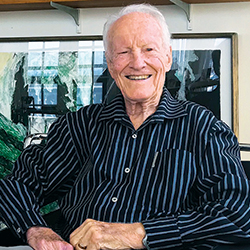An Engineer's Mind with an Artist's Eye
Jim Krebs reflects on a rich, full life of serving his country, designing airplane engines, collecting art, and giving back to Northwestern Engineering.
 The way Jim Krebs ('45) figures it, an airplane fitted with an engine he helped design takes off or lands somewhere in the world every two seconds.
The way Jim Krebs ('45) figures it, an airplane fitted with an engine he helped design takes off or lands somewhere in the world every two seconds.
Considering he worked nearly 40 years at General Electric on 18 different engines for 30 different airplane models—and originated the high-bypass turbofan, which became industry standard—he’s probably right.
But he couldn’t have imagined such a career growing up in Minnesota and northern Illinois during the 1930s. He was interested in sketching airplanes, rocket ships, and cars, but never considered himself a handy guy. “But I did like the idea of making things, and I thought engineering sounded sensible,” he says. As a high school senior in 1942 he was attracted to Northwestern’s then brand-new Technological Institute and decided to pursue a degree in mechanical engineering. Northwestern was the only school he applied to.
“Jim is the quintessential whole-brain engineer. We have had many long conversations about art, engineering, and innovation, and his success reflects that sort of thinking. It is impressive how far ahead of the curve Jim has been.”
He was awarded a full scholarship, enrolled in the Naval ROTC program, joined a fraternity, and most importantly, met his future wife Margie (SESP ’52) in their first-year English class.
“I learned the basics of engineering—math, statistics, dynamics,” he says. “I also improved in reading and writing, which I was already pretty good at, but I also really learned how to learn. I used that skill throughout my career.”
After graduating in 1945, he began active duty on the destroyer USS Dunlap, but luckily he never saw battle. While located on patrol duty off Iwo Jima, he watched P-51 fighters cavort off the island and fleets of B-29 bombers fly over each night, and began to think about getting involved in the aviation business.
After he was discharged, a Northwestern connection led to a job offer (delivered to his Quincy, Illinois, home via telegram) in General Electric’s Aircraft Gas Turbine business in the company’s Test Engineering Program. Within his first few years on the job he designed an experimental compressor. Later, he worked for many years as a component designer covering most engine sections, then as project manager of new engines.
Krebs’s real break came when he began work as general manager of Advanced Product Planning. He chose to concentrate first on the commercial transport market. At the time, commercial airplanes all used a competitor’s low-bypass turbofans, but Krebs and his team believed that making a turbofan with six times higher bypass ratio and much higher pressure ratio—which offered twice the thrust and 20 percent less fuel consumption— was possible.
“We ran the first demonstration of the high-bypass engine for a large military transport in 1964, and now everything that flies commercially has high bypass ratio,” he says. “The fact that we decided to try it and then made it work was thrilling.”
Krebs rose to the position of vice president of military engine operations in 1978. For his commercial and military successes, he was elected to the National Academy of Engineering in 1982.
“GE was a terrific company to work for,” he says. “It was exciting, and I was eager to go to work every day. There were ups and downs, but engineering is about problem solving, and I relished that.”
Still an active thinker at age 95, Krebs recently published an opinion piece in Aviation Week & Space Technology titled “How the Air Travel Industry Can Wage War on Climate Change.” He argues that airlines should eliminate premium-class seating over the next five years. Single-class operations, using the full capacity designed into airplanes, would be more efficient per seat mile, reducing greenhouse gas emissions while using many fewer airplanes.
Though he considered himself an engineer by trade, Krebs always loved art and collected contemporary American prints. After retiring, he and his wife bought a second home in Santa Fe, New Mexico, and began collecting Native American contemporary art. Lately he has been distributing the collections to museums in the Boston area and is donating a number of works to Northwestern’s Mary and Leigh Block Museum of Art. He’s also a lifelong photographer with many carousels of 35mm slides from his travels, and he has digitized and converted the best of his China photographs into self-published books.
“Jim is the quintessential whole-brain engineer,” says Julio M. Ottino, dean of Northwestern Engineering. “We have had many long conversations about art, engineering, and innovation, and his success reflects that sort of thinking. It is impressive how far ahead of the curve Jim has been.”
Krebs has stayed in touch with Northwestern over the years, serving on the McCormick Advisory Council and funding both the James N. and Margie M. Krebs professorships and a named lecture hall in the McCormick Education Center.
“I was one very lucky person, looking back on it,” he says. “Everything just happened at the right time and right place with the right people. Northwestern certainly got me started on that in many important ways.”
